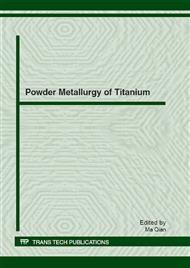[1]
A. T. Sidambe, I. A. F. Figueroa, H. G. C. Hamilton and I. Todd, Taguchi Optimization of MIM Titanium Sintering, Int. J. Powd. Met. 47 (2011) 21-28.
Google Scholar
[2]
Information on http: /www. epma. com/New_non_members/MIM. htm. Shrewsbury, (2010).
Google Scholar
[3]
R. German, Titanium powder injection moulding: A review of the current status of materials, processing, properties and applications, PIM International. 3 (2009) 21-37.
Google Scholar
[4]
F. H. Froes, Getting better: big boost for titanium MIM prospects, Met. Powd. Rep. 61 (2006) 20-23.
DOI: 10.1016/s0026-0657(06)70762-7
Google Scholar
[5]
ASTM B348 - 10, Standard Specification for Titanium and Titanium Alloy Bars and Billets, West Conshohocken, PA., ASTM International (2010).
Google Scholar
[6]
A. T. Sidambe, I. A. Figueroa, H. G. C. Hamilton and I. Todd, Metal Injection Moulding of CP-Ti Components for Biomedical Applications, J. Mater. Proc. Tech. 212 (2012) 1591-1597.
DOI: 10.1016/j.jmatprotec.2012.03.001
Google Scholar
[7]
H. Conrad, Effect of interstitial solutes on the strength and ductility of titanium, Prog. Mater. Sci. 26 (1981) 123-403.
Google Scholar
[8]
E. Baril, L. P. Lefebvre and Y. Thomas, Interstitial elements in titanium powder metallurgy: sources and control, Powd. Metall. 54 (2011) 183-187.
DOI: 10.1179/174329011x13045076771759
Google Scholar
[9]
D. J. Simbi and J. C. Scully, The effect of residual interstitial elements and iron on mechanical properties of commercially pure titanium, Mater. Lett. 26 (1996) 35-39.
DOI: 10.1016/0167-577x(95)00204-9
Google Scholar
[10]
M. L. Wasz, F. R. Brotzen, F. R. McLellan and A. J. Griffin, Effect of oxygen and hydrogen on mechanical properties of commercial purity titanium, Int. Mat. Rev. 41 (1996) 1-12.
DOI: 10.1179/imr.1996.41.1.1
Google Scholar
[11]
A. T. Sidambe, I. A. Figueroa, H. G. C. Hamilton and I. Todd, Metal injection moulding of Ti-64 components using a water soluble binder, PIM International. 4 (2010) 56-62.
Google Scholar
[12]
MPIF Standard 35, Material Standards for Metal Injection Molded Parts, Princeton, NJ, Metal Powder Industries Federation (2000).
Google Scholar
[13]
A. T. Sidambe, W. Xu, I. A. Figueroa, H. G. C. Hamilton and I. Todd, Rapid Debinding of a Titanium Component, Mannheim (2008), EPMA, 2, 275-280.
Google Scholar
[14]
ASTM E8/E8M-08, Standard Test Methods for Tension Testing of Metallic Materials, West Conshohocken, PA., ASTM International (2008).
Google Scholar
[15]
ASTM F2885 - 11, Standard Specification for Metal Injection Molded Ti-6Al-4V Components for Surgical Implant Applications, West Conshohocken, PA., ASTM International (2011).
Google Scholar
[16]
A. T. Sidambe, I. A. Figueroa, H. G. C. Hamilton and I. Todd, Improved Processing of Titanium Alloys by Metal Injection Moulding, IOP Conf. Ser.: Mater. Sci. Eng. 26 (2011).
DOI: 10.1088/1757-899x/26/1/012005
Google Scholar
[17]
T. Ebel, W. Limberg and F. P. Schimansky, Metal Injection Moulding of Advanced Titanium Alloys, 'Advances in Powder Metallurgy & Particulate Materials, San Franscisco (2011), MPIF, 1. x.
DOI: 10.1179/1743290112y.0000000020
Google Scholar


